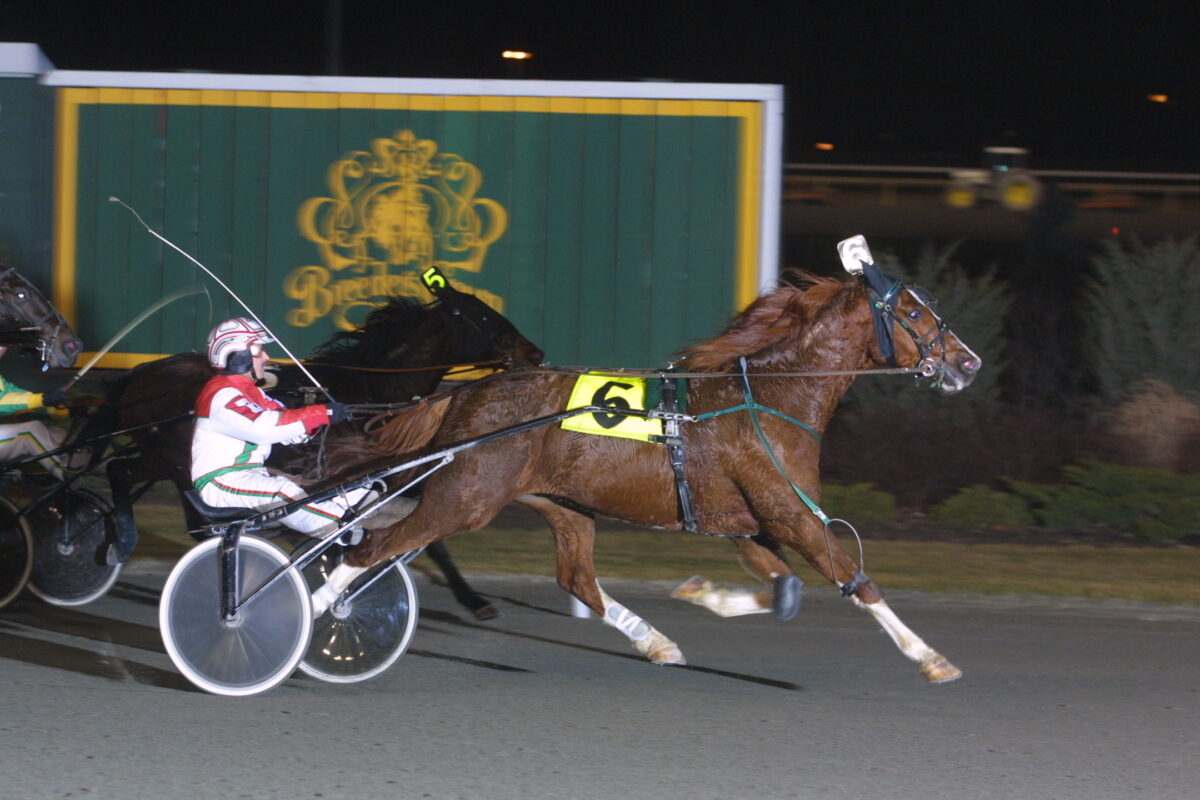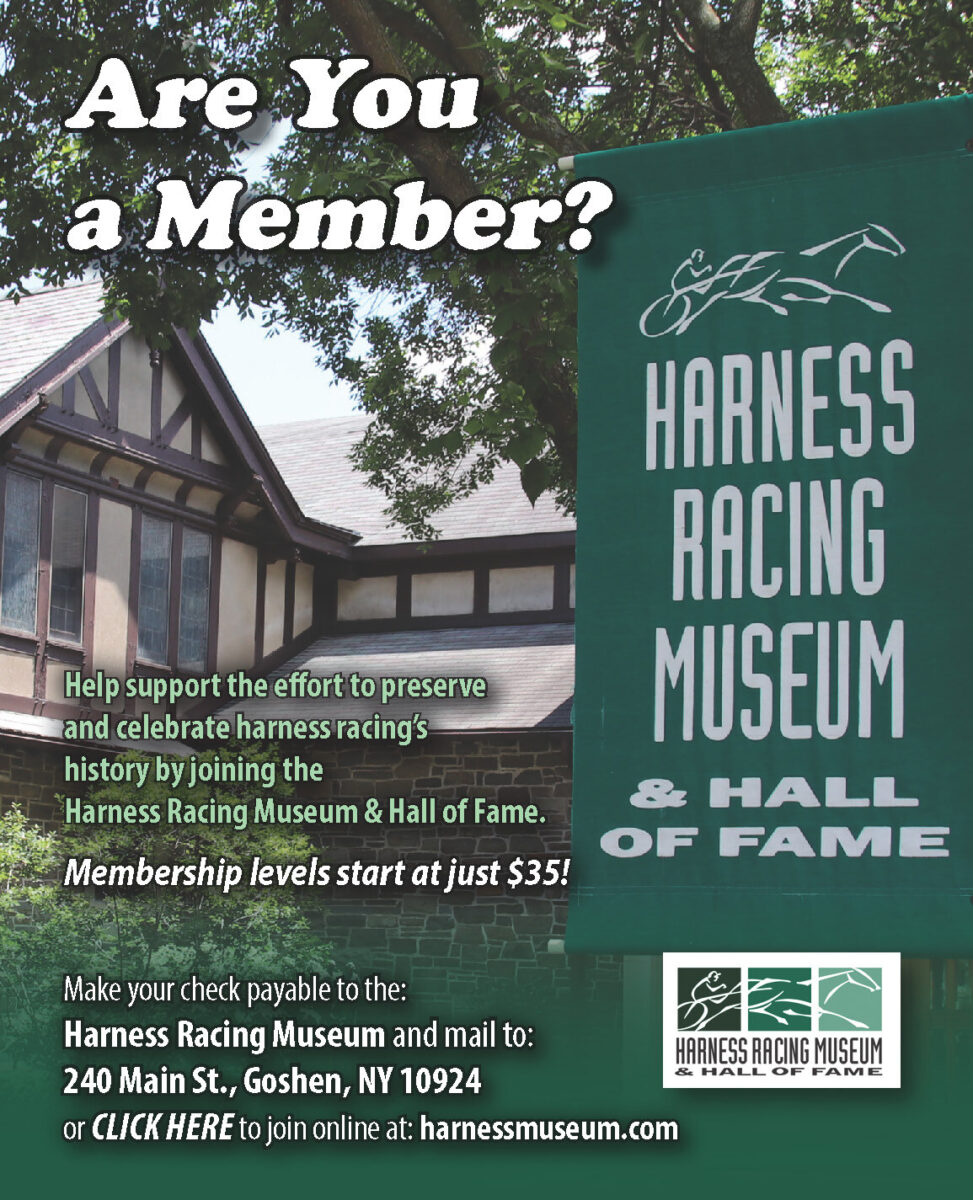Remembering colorful standout Im A Standardbred
by Melissa Keith
As The Meadowlands celebrated the arrival of Irish pinto pacer Always B Colour IR on Saturday (April 5) night, the news evoked memories of perhaps the most colorful horse to compete at Mohawk Raceway/Woodbine Mohawk Park.
On May 18, 1992, an unusually marked mare owned by Sydney Norris of Brantford, ON gave birth to an extraordinarily flashy colt. The mare, simply named T (5, 2:03f; $30,166), was a Florida-bred by solid bay stallion Star Shot out of the unraced mare Stonegate Worthy, a bay mare with a star, snip and strip on her face, and one white sock. Star Shot (3, TT1:58.1m; $132,010), owned by John J. Walker of Delray Beach, FL, sired 13 chestnut foals among his 98 registered offspring, passing along the distinctive color of his own sire, 1959 Dan Patch 2-Year-Old Trotter of the Year Blaze Hanover (3, 1:59.4m; $239,069).
T raced from 1984 through 1987, winning 16 of 64 starts and taking her 2:03 lifetime mark at Mohawk. The bay mare’s more remarkable marks were her blaze and the spot on her lower lip, her left hind white ankle, and her completely white front and hind right legs.
T was not a registered pinto, but she almost certainly was a sabino. The University of California Davis Veterinary Genetics Laboratory website described sabino as an “autosomal incompletely dominant trait” which shows up as “irregular spotting, usually on the legs, belly, and face, often with extensive roaning.” The website noted that if sire or dam passes along the sabino 1 allele, the result can be “horses with two or more white legs or feet, often with white running up the anterior part of the leg, an extensive blaze, spotting on the midsection, with jagged or roaned margins to the pattern.” If both parents pass along the sabino 1 allele, the offspring will typically be “at least 90 per cent white.”
When Sydney Norris bred T to Armbro Bullet (8, 2:00.3f; $302,477), he was likely aware of the stallion’s famously chrome-sporting sire, Dream Of Glory (3, 1:57.2m; $473,316), if not the genetics of sabino. While Armbro Bullet was bay with little white on his coat, three-time Dan Patch Award winner Dream Of Glory was a dark bay with a star with connecting strip and long snip on his face, plus white on his outer left front coronet, right front ankle, and both hind half-legs. When combined, the genetics of Armbro Bullet and T resulted in a colt so unique that his looks belied his breeding.
The colt was fittingly named Im A Standardbred.
As Dave Little reported in his Meadowlands media release about Always B Colour IR, horses of a different color are seldom high achievers on the racetrack in harness racing. He quoted the stallion’s trainer, Shane Tritton, about the reason why skewbald (i.e., brown, bay or chestnut with large white patches) pinto standardbreds even exist today.
“They have skewbalds racing in Australia and Europe, but they’ve always had a notorious history of not producing the best horses,” Tritton said. “People want these things and try to breed them because they love the coloring but not many of them have turned out to be high-quality racehorses.”
Unusually-colored harness horses have sometimes inherited this trait from non-standard bloodlines originating outside of the standardbred breed. Not so for Im A Standardbred (8, 1:57s; $388,906), who was all trot when he won his first schooling race at Quebec’s Connaught Park by 16 open lengths in 2:17 flat on June 18, 1994. He finished second as the beaten favorite in his pari-mutuel debut, an Ontario Sires Stakes 2-year-old colt trot at Kawartha Downs on July 30, 1994, for owner/trainer/driver Erwin Stewart. He made seven more OSS starts that season, finishing fourth behind winner Armbro Norbert in the $98,280 finale at Windsor Raceway on Nov. 26, 1994. With four wins from 17 starts and a mark of 2:04.3 taken at Rideau Carleton Raceway for Stewart, Im A Standardbred was establishing himself as a dependable trotter who would race every season until his final start on Nov. 8, 2002 at Mohawk.
Canadian Hall of Fame driver Dave Wall first picked up the catch drive on Im A Standardbred in OSS action at Windsor Raceway. The gelding was interfered with early in a $101,720 event on Oct. 2, 1994, but reset for a show finish behind Larry Walker’s Going Smartly. Wall teamed up with Im A Standardbred for 69 of the striking chestnut’s 239 starts, mainly driving him at Mohawk and Woodbine Racetrack later in the trotter’s career.
Dave Wall’s son, Dean Wall, told HRU that while his father had some memory issues that (understandably) prevented him from recalling details from his 48,541 lifetime drives, Im A Standardbred stood out for everyone who watched him on the track. Dave Wall’s memory was affected by “a few bad accidents over the years, so he watches the races and he knows all the horses and that, but he forgets that he talked about it a couple of minutes ago,” said Dean.
“Dad and Kevin Davidson had a lot of success over the years,” said Dean, referring to the now-retired trainer who campaigned Im A Standardbred intermittently for a total of 116 starts together. “Kevin went out on his own, I think in the ’90s.”
Davidson’s first race with Im A Standardbred was a place finish for Dave Wall at Mohawk on Oct. 22, 1996-the gelding’s second-ever start at the Campbellville, ON showplace. Im A Standardbred previously finished sixth there with owner/trainer Stewart in the sulky for a May 21, 1995 OSS Gold elimination for 3-year-old trotting colts and geldings.
“He was a chestnut, I remember,” said Dean, speaking of Im A Standardbred. “He had all these funny markings on him. The thing I remember about him racing is that he didn’t leave very good. He didn’t get off the gate very good, so he was first-over almost all the time, and when they hit the head of the stretch, coming down the homestretch, he was always the one on the outside, and he just stood out like a sore thumb… He’d be out in the center of the track, and he just stood out with all that chestnut and then the white markings on him.”
Dean said he remembered the effect that Dream Of Glory had on Ontario trotters during the late stallion’s heyday.
“Dream Of Glorys had a lot of white on them,” Dean said. “A lot of them had three or four white feet. That’s probably part of where [Im A Standardbred’s] color came from.”
While he didn’t have personal memories of working hands-on with the flashy chestnut-and-white trotter, Dean said he saw a lot of him.
“I traveled with my dad pretty well every night in my teen years,” Dean said. “After I left school, we’d be off to Greenwood and I’d do my homework in the van, and I saw a lot of these horses race a lot. I would work on the weekends and that, until I was done with school, and then I started full-time once I graduated high school. I was working for dad and now I have my own stable.”
In his own racing career, Dean said he had never seen another standardbred like Im A Standardbred, but he knew of some deliberate efforts to produce white standardbreds in Ontario.
“There’s a couple of pure white horses at the Durbridges’ [Norman and Bill Durbridge of Dutton, ON], not a mixture or anything like that… They went out of their way to breed to get these white horses, and they ended up getting a couple. One [Maximum White (p, 5, 2:03.3h; $17,605)] did make the races.”
Looking back at the career of Im A Standardbred, Dean said he was somewhat surprised by the trotter’s earnings.
“He made more money than I even thought… that’s a tough grind, especially without a lot of stake earnings,” he said.
The gelding made 58 lifetime starts at the preferred level, primarily at Rideau Carleton, where he won 15. He took his 1:57 flat mark at age 8, racing in non-winners of $40K company at Woodbine for Dave Wall and Davidson. His one appearance in the Mohawk preferred was when he finished seventh of 10 trotters on Nov. 26, 1999, in an edition won by Turnpike Token.
Dean said Always B Colour IR’s North American debut naturally raised questions about the scarcity of other colorful standardbreds today.
“Did you see the horse at The Meadowlands?” he said. “That’s quite a unique-looking horse there too, eh?”
He wasn’t sure that pinto or other unusually-colored standardbreds would ever become a trend in harness racing, for one reason.
“I don’t know, maybe the fans like the flashy ones, but I don’t think the trainers do, because I think the trainers always think there’s too much attention on those horses, and it almost works out as a jinx,” he said. “I think horsemen just like their horse to be plain [bay or brown], maybe a black one.”
He added, with a laugh, “It’s hard to hide a horse out on the racetrack or at a training center when you’ve got a horse with four big white feet and the thing is going terrible. Everybody notices that one.”


















